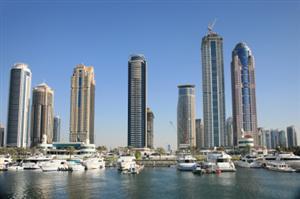| Complexity level: | 7 |
| Project cost ($): | 90 |
| Time required: | 1 day to prepare, 1 day for observation |
| Material availability: | Fairly easily found |
| Safety concerns: | Basic safety requirements. Ensure that you handle the fan with care to avoid accidents. |
Hypothesis
A skyscraper with a circular cross-section will be able to withstand the greatest force of wind.
Overview
Skyscrapers
As buildings are built taller than ever, these skyscrapers have to deal with increasing vertical gravitational forces as well as horizontal forces resulting from wind. Just like swaying palm trees, these skyscrapers actually are able to sway several feet in any direction without causing any damage to the integrity of their structure.
However, it is important to consider how this movement affects the occupants inside these buildings. The movement will be felt more evidently on higher floors. Special design features such as the use of internal counterweights to help shift the weight of the building towards it’s center, are built into the structure of the building. These measures help counter the horizontal forces caused by wind.
The height limit of skyscrapers is not determined primarily by the structural material used to construct the building. The main factors that limit a skyscraper’s height are wind forces, limitations to the elevator systems and of course, budget. On a calm day, at an altitude of two kilometers, skyscrapers have to deal with 35km/hour wind speeds. At an altitude of 10 km, wind speeds can increase significantly to as much as 288km/hour. However, the air will also become thinner at higher altitudes, reducing the force of wind on the building.
The shape of a skyscraper, especially on higher floors may affect how the building deflects wind. The Burj Khalifa skyscraper in Dubai for example, is built on several separate stalks, which top out unevenly around the central spire to help the building withstand against the stress of wind.
Scientific Terms
Materials
The materials required for this science fair project:
- An high-velocity fan with 5 fan speeds. It would be best if you are able to find an industrial fan
- 4 pieces of polystyrene foam measuring 200m x 200mm x 500mm
- 4 pieces of plywood measuring 600mm x 600mm x 1500mm
- A hammer
- 1 box of nails
- A ruler
- A pen-knife
- 4 boxes of playdough
Procedure
1. For this science fair project, the independent variable is the shape of the buildings, i.e. with a rectangular, triangular, circular or oval cross-section. The dependent variable is the velocity of the wind that the model building can withstand before it collapses. This is determined by gradually increasing wind speed and observing the model buildings. The constants (control variables) are the size of the model buildings, the amount of playdough used to mount the building and the size of the wind tunnel.
2. Using 4 pieces of plywood, nails and a hammer, build a square wind tunnel measuring 600mm x 600mm x 1500mm. Position the industrial fan at the entrance of the wind tunnel.
3. Next, using the paper knife, cut the 4 pieces of polystyrene foam into model buildings with a rectangular, triangular, circular and oval cross-section. The height of the 4 buildings should be 500mm and their cross sectional area should be the same.
4. Mount the 1st building to be tested on the opposite side of the wind tunnel, away from the fan. Use one box of playdough to mount the model building onto the floor of the wind tunnel. Increase the speed of the industrial fan gradually and observe at which speed the model building collapses. Record your observations in the table below.
5. Procedure 4 is repeated with the other 3 model buildings and the results are recorded in the table below.
Results
It was observed that the model building with a circular cross-section withstood the greatest force of wind, while the model building with a rectangular cross-section was the least resistant to wind.
It was observed that the model building with a circular cross-section withstood the greatest force of wind, while the model building with a rectangular cross-section was the least resistant to wind.
| Shape | Model skyscraper shape and high speed wind tolerance. | ||||
| Speed 1 (low) | Speed 2 | Speed 3 | Speed 4 | Speed 5 | |
| Rectangular | Y | X | X | X | X |
| Triangular | Y | Y | X | X | X |
| Circular | Y | Y | Y | Y | X |
| Oval | Y | Y | X | X | X |
Y - model building remained upright, X – model building collapsed
Conclusion
The hypothesis that a circular cross-section shaped skyscraper will be able to withstand the greatest force of wind is proven to be correct.
Apart from wind factor, another limitation in building skyscrapers is in meeting elevator requirements. Taller buildings have more people working or living in them and therefore more space needs to be allocated for elevators on the ground floor. To overcome this problem, double- decked elevators and sky lobbies are used as intermediary points to improve efficiency of the elevator system.
Also consider
The experiment can also be done by constructing model buildings with denser material such as wood.
It would also be interesting to ascertain if the type of surface or paintwork on a building will affect its resistance to wind forces. For example, would a building with an exterior consisting mainly of glass or metal be more resistant to wind, than one consisting of masonry?
References
How skyscrapers work - http://science.howstuffworks.com/skyscraper4.htm
How tall can skyscrapers be? - http://www.wisegeek.com/how-tall-can-skyscrapers-be.htm

